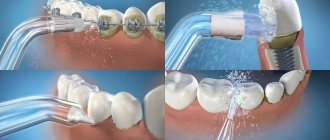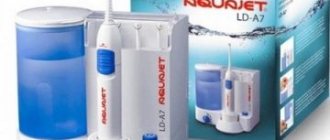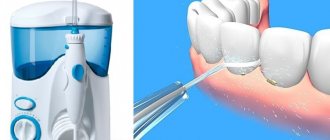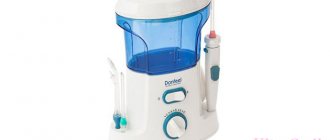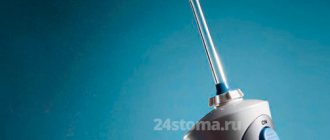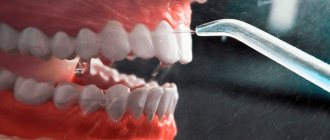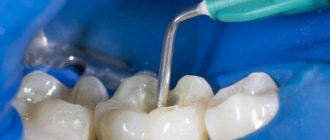The health and beauty of your teeth largely depends on how carefully your oral hygiene is maintained. Cleaning teeth from food debris and plaque with a toothbrush, due to the complexity of the dentition, the presence of hard-to-reach areas, and interdental spaces, is not effective enough. Dentists have long used irrigation in their professional practice to clean teeth. Now the home arsenal of dental care products has been replenished with a new device - an oral irrigator.
Why do you need an irrigator?
Irrigator is a derivative of the Latin word irrigatum, which means “to irrigate.” This is a device that allows you to use water to clean your teeth from organic residues remaining in the mouth after eating. The irrigator does not replace the action of a toothbrush. An irrigator is especially necessary when wearing orthopedic devices (bridges, brackets, brackets and others). With its help, structural elements and the surface of the teeth that come into contact with them are cleaned.
Contraindications for use of the device
In addition to the enormous benefits, the presented device has contraindications:
- postoperative period of dental surgery;
- stage of exacerbation of gum disease;
- recovery period after installation of braces or implants;
- diseases of the cardiovascular system, which lead to bleeding gums due to damage to blood vessels;
- period of course treatment of dental diseases.
It is not recommended to use the irrigator for children under 6 years of age, as well as for those people who have previously experienced prolonged bleeding of the gums.
Operating principle of the irrigator
The principle of operation of the irrigator is based on the flow of a very thin stream of water under high pressure onto the elements of the oral cavity to be cleaned. This method of treating the oral cavity not only washes out the smallest food debris and removes plaque from the teeth, but also massages the gums, which improves blood circulation. The device consists of a hydraulic pump, a container for liquid and a handle with replaceable nozzles.
The reservoir is filled with water or solution, under the action of the compressor the pressure rises, and the liquid rushes to the handle with the nozzle. Different irrigator models provide a variety of water jet supply modes, which can be pulsating, spraying, constant, centered, or spraying. The liquid used is plain water or solutions with added agents that enhance the therapeutic and preventive effect of the procedure. Solutions of fluoridated, calcined liquid, antiseptics, antibacterial drugs, herbal infusions, and compositions for strengthening gums are used. Special attachments on the handle ensure that the water jet reaches areas of the dentition that are inaccessible to a toothbrush and floss.
Which irrigator is better - choosing the right device for teeth
In order not to make a mistake when making a purchase, you should pay attention to the following criteria:
- Type of product: stationary or portable. It is important to keep in mind the conditions in which it will be used most often.
- Possibility of pressure adjustment. If the unit is purchased for the whole family, then it must be multifunctional. Then adults will be able to increase the pressure and strength of the jet, and people with bleeding gums and children, on the contrary, will be able to decrease it.
- Modes. Most models have several operating schemes. You should pay attention to the fact that the device operates in pulsation, micro-massage, floss, spray, and turbo flow modes. Then it can rightfully be called universal and convenient.
- Power. The pressure with which the water jet will be supplied depends on this characteristic. In stationary mechanisms, the power is usually from 600 to 800 kPa, in portable ones - from 250 to 600 kPa.
- Availability of additional attachments. The more there are, the better - the more opportunities a person has to take the best possible care of the oral cavity. Patients who wear braces should prefer designs with orthodontic and periodontal tips.
- Continuous operation time. It is recommended to consider this parameter only if you purchase a portable model. In order for the device to function for a long time, experts recommend giving preference to lithium-ion batteries.
- Ripple. It is optimal if the product produces about 1200 pulsations per minute. In this mode, not a trace remains of the soft coating.
- Tank volume. In portable models the tank is larger, in stationary models it is smaller. You need to select a product taking into account the number of family members and the usual duration of brushing your teeth. If a person buys a device only for himself, he is unlikely to need a tank that holds 800 ml.
Benefits of an irrigator
The benefit of the irrigator is better cleaning of the oral mucosa, surface of the teeth, interdental spaces, as well as orthopedic structures. And the absence of a biological substrate for the proliferation of bacteria and the rotting of food debris is the prevention of the development of dental diseases. Medical studies have found that a three-second treatment with pulsating water using an oral irrigator removes up to 99.9% of bioplaque on teeth.
Oral irrigator features:
- Significantly reduces the risk of developing caries.
- Promotes rapid healing of gums through micromassage.
- Disinfects and refreshes the oral cavity with antiseptic solutions.
- Cleans gum pockets and prevents the development of periodontal disease.
- Treats the oral mucosa with medicinal solutions for stomatitis
- Prevents the deposition of pigment on the surface of tooth enamel when smoking, drinking strong coffee, tea, red wine.
- Removes plaque from the mucous membrane of the tongue and gums, which reduces bacterial contamination of the oral cavity.
- Prevents destruction of the enamel coating of teeth when installing braces, braces and other orthopedic devices.
- To reduce trauma to soft tissues due to bleeding and loosening of the gums, replace the toothbrush.
Key factors when choosing an irrigator
If you want to improve blood circulation in the gums, reduce the risk of inflammation and increase the service life of dental implants, using irrigators on an ongoing basis is simply necessary. Above we have presented the best model range, but if none of the options suits you for some reason, check out the parameters that will help you choose the ideal solution yourself:
- Water pressure
. The most important aspect that directly affects the quality of oral cleaning. The stronger the pressure, the more effective the irrigator, it's simple. - Tank volume
. Consider this parameter to purchase a device that can perform its task for a long time and productively, and not require refueling every 30 seconds. - Type of jet
. Water is supplied in different ways, most often it is a pulsating and micro-bubble type of pressure. - Pulsation frequency
. Having given preference to a pulsating jet, you need to figure out what frequency of blows is presented on the device. It would be desirable to have a separate intensity control function. - Equipment
. A rich set is always nice, but keep in mind that much of what comes in the package can be purchased independently if the need arises. - Type of design
. You remember that we talked about both portable and stationary irrigators. Determine your tasks and buy the right solution. - Types of nozzles
. If you wear braces or have very sensitive gums, find out in advance whether a certain type of attachment will suit your needs or not.
The irrigator can be used for both preventive and therapeutic purposes. Doctors recommend the use of such devices for gingivitis, gum disease, periodontitis, various malocclusions and periodontal disease. In short, an irrigator is a universal solution for cleaning teeth. Choose a device based on our recommendations, then the irrigator will only delight you with taking care of your oral health.
Types of irrigators
Types of irrigators differ from each other in technical characteristics, design, and operating principles. Stationary models are placed in the bathroom and operate from the mains. They are equipped with a large capacity for liquid and have a powerful engine that creates a high level of pressure. The device is usually used by the whole family, so it comes with many attachments.
Diseases of the ENT organs and frequent acute respiratory viral infections
Rinsing your nose with a solution of table salt is something that is recommended to almost everyone and always for sinusitis, frequent runny nose, and exposure to ARVI. The mucous membranes of the nasopharynx very often suffer from dryness - this is both the consequences of poor ecology and thinning under the influence of drugs. And dry mucous membrane becomes easily permeable to viruses and bacteria.
The most common solution of table or sea salt (half a teaspoon per glass of water) not only disinfects, but also restores the moisture of the mucous membranes, so rinsing the nose with an irrigator and a special nozzle is an alternative to pharmaceutical sprays “with sea water”, which are most often not made from “Adriatic water”, but from saline solution. It's not bad, it's just not very fair, and it's also expensive.
If there are several attachments in the set, then the whole family can use the irrigator (this applies not only to nasal attachments). The lowest pressure is used to rinse the nose.
Flaws:
- The energy source is too small to create the required water jet pressure.
- The need to frequently replace batteries or charge the battery.
- The volume of water is not enough to fully clean the oral cavity.
- Flow irrigators are attached to a water tap and use the pressure of the water supply system. Special tap valves allow you to regulate the fluid pressure.
- Mechanical types of irrigators are now rarely used. These are devices in which the pressure required to produce a jet is achieved by mechanical action on the piston. There is a key on the body of the device that is pressed to increase the pressure in the vessel with the liquid. The efficiency of such a device is low
- Tap water mixed with chlorine and heavy metal salts enters the oral cavity.
- There is no pulsation mode.
- Often the water pressure is not enough for effective cleaning.
- Modern models use the latest fine-bubble cleaning method, which is considered the most effective.
- The pulsation mode also promotes the rapid removal of microparticles of organic substances from teeth and orthopedic structures.
The best plant-based mouth rinses
Forest balm
Mouthwash from the Forest Balm brand is intended for comprehensive maintenance of the oral cavity in a healthy condition. It will not solve serious problems, it is intended mainly for prevention. The product protects against caries and strengthens enamel due to a mineral complex with fluoride. The Russian concern Kalina produces Forest Balsam rinse in 13 versions, not all of them have a purely herbal composition. Some may contain fragrance, an organic solvent, or the antiseptic triclosan. When purchasing, you should pay attention to the components included in the product. Main advantages:
- pronounced effect,
- pleasant taste,
- affordable price.
Minuses:
- the composition is not 100% natural.
MEXIDOL dent Professional
Rinse aid made in Russia. The composition includes: anti-inflammatory component methylhydroxyperidine succinate (or Mexidol), licorice root extract, amino acid complex. Suitable for periodic use, prescribed to prevent the development of inflammatory processes for people prone to developing stomatitis and those who wear removable dentures. Main advantages:
- moisturizes the mucous membrane,
- heals wounds with stomatitis well.
Minuses:
- Recommended only for certain diseases.
Types of removable attachments
Several types of attachments have been developed to perform various oral hygiene tasks:
- The standard one is used for daily brushing of teeth.
- Periodontal is designed to cleanse gum pockets.
- Nozzle for removing plaque from the tongue.
- The orthodontic attachment is used to care for braces and other dental devices.
- The brush attachment performs the work of a classic toothbrush and massages the gums.
- The teeth whitening attachment is used in the process of cleaning and polishing the enamel.
- Manufacturers of irrigators and their features
- In the modern market of dental devices, irrigators are presented in a wide range.
Content:
- What is this?
- How Irrigation Systems Work - A Brief Overview
- Who should buy
- What to look for when choosing
- Types of equipment for cleaning technology
- Which irrigator is better - choosing the right device for teeth
- How to use it correctly
- When not to use
To ensure the best possible care for your teeth and gums, it is not enough to use only toothpaste, brush and floss. It is also advisable to arm yourself with an oral irrigator. By choosing the best device for yourself, a person will be able to avoid many dental diseases and problems.
Dentist advice
Before you start using the device, you need to consult a dentist who will help you choose the optimal fluid supply mode, frequency of use, and solution composition. Compliance with all operating rules is the key to safe use of the irrigator. Rules for using the irrigator:
- Cleaning should begin with a gentle regime, gradually increasing power over 7-10 days.
- It is not recommended to use the device earlier than 24 hours after installing any orthodontic structures in the oral cavity.
- The liquid stream should be directed towards the teeth at a right angle.
- It is permissible to use an irrigator for children from 6-7 years of age, always under adult supervision. A high-pressure jet of water entering a child's windpipe can cause tracheal spasm and asphyxia.
- Long-term use of aseptic solutions can disrupt the normal microflora of the oral cavity and cause dysbacteriosis.
- The device can be used for gingivitis and periodontitis only during remission.
- The duration of the procedure is 5-10 minutes.
What is better: water or special solutions?
Ordinary clean water is poured into the irrigator’s container, as a rule, in the absence of any oral diseases and to save money. Professional solutions are used if there are pathologies. They usually contain healing components that help cure the disease.
The remedy is thus selected depending on the disease. It is also allowed to use special liquids of the general spectrum for their prevention. Home remedies containing salt, baking soda and hydrogen peroxide are not recommended.
Making your own irrigator from a syringe
An irrigator can be made from a syringe. To do this you will need the following tools:
- 5 ml or 20 ml syringe (volume depends on personal needs);
- sandpaper for grinding down the needle point;
- mouth rinse.
Tools for making a DIY irrigator
The device is quite easy to make yourself. To do this you will need to do the following:
- Take the needle from the syringe and carefully grind off the tip with sandpaper. You can use sharper tools, such as a knife, to remove the pointed part. Next, you need to sharpen the damaged surface so that when using a homemade device, family members do not damage the gums.
- Carefully bend the remaining part of the needle so that it resembles a standard nozzle in shape.
- If the needle cannot be bent, you can heat it a little over the fire and carefully bend it into the required shape.
- To use a home-made device, you need to assemble the syringe, remove the plunger and pour in the used teeth cleaning product.
- Then insert the piston into the syringe and, using gentle pressure, provide the necessary pressure for the jet. In this way, the interdental spaces are cleaned from food debris, protecting teeth from plaque.
Option for a homemade irrigator from a syringe
Some masters use a speed regulator from a simple medical dropper instead of a needle. To do this, cut off the required length of the nozzle and secure it with wire. The regulator can be used to adjust the fluid supply power. The homemade device is not recommended for use for cleaning the mouth of children.
Syringe with dropper regulators
Seven signs to look out for
Do you want to check how your toothbrush copes with its function and whether the Waterpik irrigator has advantages? You can assess the condition of your teeth using these signs:
- presence of caries,
- the presence of tartar (hard plaque that hardens on the teeth as a result of insufficient daily brushing),
- presence of bacteria on teeth,
- presence of gum disease (bleeding and others),
- Are your teeth hypersensitive (do they react to things that are too cold or too hot with aching pain),
- “yellowishness” of teeth or the presence of so-called dark plaque,
- freshness of breath, which is also reflected by the presence of food debris between the teeth.
The detection of several of the seven signs directly indicates that the quality of oral hygiene is insufficient. Clinical studies prove that long-term use of the Waterpik irrigator significantly reduces the risk of identifying seven so-called signs of unhealthy teeth.
Is it possible to make an irrigator at home?
Oddly enough, it is quite possible to make an irrigator at home yourself. Several options are offered:
- The first method is an irrigator from a syringe - for this you need to select a suitable syringe (at least 5 ml, at least 20, at the discretion of the specialist), sharpen the needle from the syringe a little so that it is not sharp, and bend the tip. The irrigator is ready. Effectively rinses the interdental space.
- The second option is a flow-through irrigator - a nozzle with a silicone or rubber tube is screwed to the shower hose. Ready. The water tap opens and the liquid flows out through the rubberized hose.
Taking care of the oral cavity is becoming a very popular task among modern youth, and all options are good on the way to this goal. Using an irrigator, you can forget about gingivitis and periodontitis. Your teeth will be cleared of plaque, and there will never be any odor. But at the same time, you should not forget about the rules for using the device, and, of course, it is best to get advice from a specialist before using it.
Rating of the best inexpensive liquids for irrigators
The best refreshing and antiseptic solutions for irrigators are quite expensive. But in the budget segment you can also find effective and safe products.
ROCS AirFloss PRO
The Russian solution for simple rinsing or use with an irrigator has anti-inflammatory and strengthening properties. The product contains calcium, phosphorus and magnesium, and there are natural additives, including kelp extract. The liquid stops the proliferation of bacteria in the oral cavity and reduces the likelihood of developing caries, dissolves plaque and has a whitening effect.
Attention! ROCS AirFloss does not contain parabens, alcohol or sulfates and is therefore not harmful if accidentally swallowed.
You can buy ROCS AirFloss from 130 rubles Pros
natural composition; good antibacterial properties; whitening effect without harm to enamel.
Cons: Sold in small bottles; short shelf life.
Albadent
The irrigator concentrate has a multi-component formula consisting of anti-caries, bioflavolipid and soothing additives. Contains relict ginseng extract, calendula, chamomile and St. John's wort, helps with bleeding gums. You can use irrigator liquid to prevent tartar and for gentle whitening. The solution freshens breath well and gets rid of even the persistent smell of tobacco.
You can buy Albadent from 260 rubles Pros
pleasant taste and aroma; when used with an irrigator, the product lasts a long time; the solution removes plaque and fresh tartar.
Cons: foams when applied; the irrigator may clog; burns sensitive mucous membranes.
Dental Volk Technologies
The strengthening solution for the irrigator has pronounced analgesic properties. It is beneficial for sensitive enamel and bleeding gums, eliminates bacteria and is suitable for the treatment of inflammatory processes. The composition contains plant extracts of echinacea and chamomile, and peppermint is responsible for the refreshing effect. The liquid does not contain dyes, alcohol or parabens, so even children can use it.
The price of liquid for the Dental Volk irrigator starts from 270 rubles Pros
safe hypoallergenic composition; antibacterial effect; The solution lasts a long time.
Disadvantages: the concentrated product must be diluted; Not everyone likes the taste of the liquid.
Donfeel
The balm contains sage, chamomile and oak bark extract, as well as the antiseptic substance thymol. Suitable for gum care for periodontal disease and gingivitis, normalizes the microflora of the oral cavity. Rarely causes negative reactions and is equally well tolerated by children and adults.
The price of Donfeel solution starts from 230 rubles Pros
relieves inflammatory processes in the oral cavity; effectively cleans gum pockets from germs; has a pleasant cooling taste
Cons: quickly used up; It is not recommended to swallow the product.
Forest balm
Another cheap Russian rinse is suitable for use with an irrigator, effectively treats gums and relieves inflammation and pain. When used daily, it restores mucous membranes and prevents plaque formation. You can use irrigator liquid for weakened enamel and periodontitis.
Attention! Forest balm is completely safe in composition and is approved for use even during pregnancy.
You can buy Forest Balsam for only 70 rubles Pros
low price; good antibacterial and restorative properties; safe if accidentally swallowed.
Cons: Does not have a whitening effect; in concentrated form, it burns the mucous membranes.



